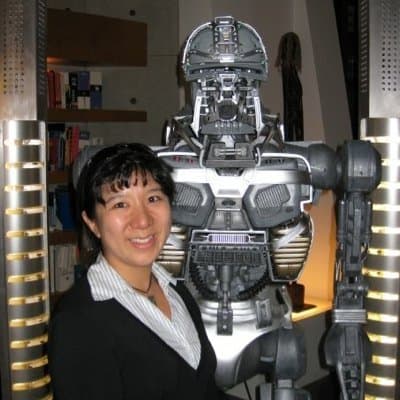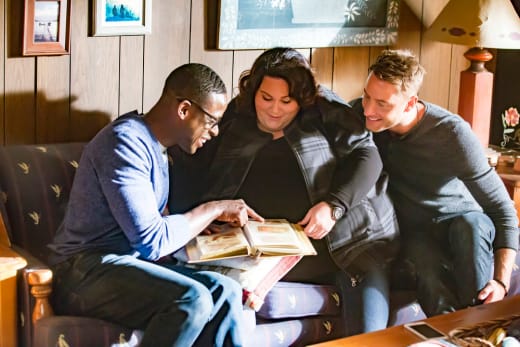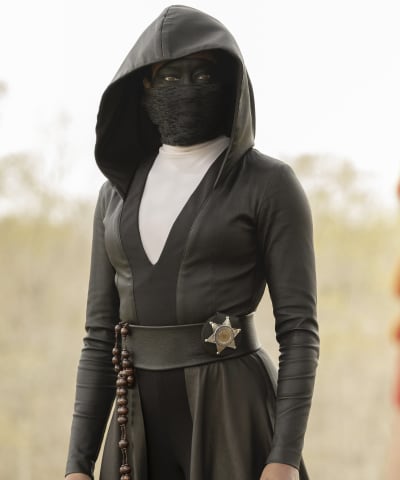Westworld, The Witcher, and Watchmen: How Time Gets Twisted on Today's TV
 Diana Keng
at
.
Diana Keng
at
.
With so much exciting TV out there these days, is it any wonder that writers and showrunners are constantly searching for new and creative ways to deliver a story?
HBO's Westworld made a breakthrough in 2016 with the revelation/confirmation on Westworld Season 1 Episode 10 that (SPOILERS!) William and the Man in Black were, in fact, the same person with thirty years of living and tragedy turning his original white-hat optimism into the bleakest of black-hat ennui.
The perspectives of all the hosts were suddenly invalid somehow, especially when some of the hosts didn't even know they were hosts.
It was a total brain-bender for those who had been drawn into the misleading paradigm of the show.
In many ways this was the fashion of the time. Shows with unreliable narrators (e.g., FX's Legion, USA Network's Mr. Robot, Showtime's The Affair) had become de rigeur but found that without the ability to trust the narrator, it was challenging for audiences to identify with the characters.
That's not to say people don't like shows with unreliable narrators, just that it inhibits the audience's ability to immerse themselves in the story when they know the perspective isn't true. There's always the sense of waiting for the real story to emerge.
So the other piece of Westworld's twist was non-traditional, non-linear chronology, a device that has been played with in both film and TV for decades but which has suddenly become the new hotness for showrunners.
If you can't play with the who, you play with the when.
Because our natural instinct is to assume that everything we see happening is happening at the same time, when time itself turns out to be the secret ingredient, the #MindBlown moment can be both delightful and shocking.
The effect has been amazing across different genres within the television multi-verse.
Predating Westworld's premiere in 2016, the interwebs blew up when This Is Us Season 1 Episode 1 revealed in its final moments that the audience had simultaneously witnessed both the past and present lives of the Pearson Family.
Now into its fourth season, This Is Us has only gotten more sophisticated and intricate with its use of multiple timelines and the misdirection it excels at.
With deliberately ambiguous dialogue, clever camerawork, and ingenious timing, they've taken what might've been done in flashbacks in a less-elevated narrative and made it their trademark finesse.
In contrast to the audience's reflexive withdrawal from the presence of an unreliable narrator, multiple timelines have had the knock-on effect of layering the audience's understanding of various characters, creating deeper emotional connections and understanding.
The device also serves very well to draw viewers in by creating a puzzle that needs solving.
That's right! Television that makes us think, reflect, even question. It's sometimes frustrating, momentarily confusing, but eventually so very satisfying when all the pieces fall into place.
Netflix's The Witcher recently delivered a premiere season that ran on three separate tracks.
#SPOILER #WARNING and #OMG #HAVE #YOU #NOT #WATCHED #THE #WITCHER #YET ?!?
Much like the staggered start of mid-distance track races, The Witcher introduces us to its three main characters in three totally different time frames only to bring them into alignment by the finale.
Because both Geralt of Rivia and Yennefer are extremely long-lived individuals, there are no age indicators for viewers to clue in to how many decades exist between each narrative.
Although they are close together in age, we see Yennefer's origin story as she progresses from unwanted child to powerful mage while Geralt appears fully in play as an experienced monster-hunter.
Thus, Yennefer's tale has the earliest start date if we were to lay out the three strands of the season in some sort of linear timeline.
As the "adults" in the picture, their stories interweave first and, because Geralt makes an impulsive wish, they repeatedly "interweave" for several decades as Destiny brings them together over and over again.
Meanwhile, Ciri's adventure occurs in what we could best term "the present" in that it is the latest to occur on the aforementioned timeline.
And for those who are paying attention, it's Ciri's story that has the first time stamps to start fitting the puzzle pieces together. So we end up working backwards to sort the scenes into some sort of order.
Granted, the puzzle of The Witcher's timelines is a slow reveal. It takes a few episodes to clue into the trick of the storytelling.
There's no A-HA! moment or grand reveal like on Westworld or This is Us.
The camera shuffles between the three characters so often it develops a rhythm, and when the truth behind the timelines become clear, it's just how it is.
Call it a meta-TV Law of Surprise.
A more obvious and deliberate twisting of time is used on HBO's Watchmen, which plays with the story-within-story-within-story trope and turns it into a fractal explosion of narratives.
On the surface, Watchmen tells two primary stories. #SPOILERS
One follows Angela Abar in a post-psychic squid-attack Watchmen world in Tulsa, Oklahoma, where law enforcement officers all wear masks to hide their identities.
The other story predates the Watchmen and relates the origin of the very first masked vigilante hero of their world, Hooded Justice.
But this is when things get clever. Hooded Justice's origin is seen on a docu-series called "American Hero Story," which plays on televisions throughout the series, where an unsubstantiated but popular mythos is portrayed.
Meanwhile, bits and pieces of the real Hooded Justice's origin are meted out in flashback scenes like on the premiere whnen the 1921 Tulsa Black Wall Street Massacre is re-enacted. A massacre that actually happened in real life, not just in their alternate world.
It's on Watchmen Season 1 Episode 6, where the two stories collide when Angela takes her grandfather's pills of a drug called Nostalgia and begins to relive his life.
It turns out that Will Reeves was not only one of the first African-American police officers in New York City, but after being nearly lynched by his fellow officers for investigating Ku Klux Klan activities, he became Hooded Justice.
But his memories aren't Angela's and while she's reliving his life, her brain is trying to reassert her real memories, so we get a dizzying mix of her memories of growing up in Vietnam after her parents are killed by a suicide bomber during a VVN Day celebration.
It's an exposition explosion that manages to not only convey the hardships both Angela and Will endured but their comparative and respective desperation to make things right.
And by no means does Watchmen content itself with just recounting the Reeves/Abar backstories.
It seasons its nine episodes with a literally out-of-this-world riddle about Adrian Veidt (aka Ozymandias) the amoral genius who united the world in 1985 by producing and delivering a supposedly-extraterrestrial psychic squid that killed three million people in New York City and nearby New Jersey.
For much of the season, Veidt appears to be living in his own sort of Westworld with an inexhaustible supply of servant hosts, all drawn on either a male or female clone template known, respectively, as Mr. Phillips or Ms. Crookshanks.
Like Westworld, the days are indistinguishable from each other and what seems to us to be a week, maybe a month, of extremely deviant recreational activities is, in fact, many years of frustration and ennui and mass murder of clones.
I'll admit that I was VERY slow to realize that he wasn't, in fact, celebrating with cake every day, that each celebration was in fact marking another year of his captivity.
But it was the time-toying that threw me on the truth of Lady Trieu's ornamental statue.
In the final reveal, we discover that all of Veidt's Europa Utopia scenes were in the past, moving closer to our "present-day" with each anniversary celebration as well as his trial by clones.
In the "present-day," he had been held in stasis, sealed in molten metal, decorating his daughter's solarium.
The statue was in plain sight from Watchmen Season 1 Episode 4 onwards, even examined closely by Angela when she paid Lady Trieu a visit.
The true pinnacle of time manipulation is, hands-down, Watchmen Season 1 Episode 8, cheekily titled "A God Walks into Abar" as it retells the relationship between Angela (Abar) and Cal/Doctor Manhattan.
But -- get this -- it tells it from Doctor Manhattan's perspective.
For the uninitiated, Doctor Manhattan experiences ALL. TIME. SIMULTANEOUSLY.
Hauntingly similar to the transcendent Castle Rock Season 1 Episode 7. The entire episode is shot as experienced by a character with dementia, keeping up with Doctor Manhattan's life is a fast-paced brain-bender of nuclear proportions.
For Whovian fans, there's a heart-rending moment in Angela and Cal's kitchen that smacks of River Song's introduction on Doctor Who Season 4 Episode 8.
Cal, who knows that he is about to walk out of the house to be captured and killed, looks at Angela and -- back at their 2009 first meeting in Vietnam -- says to her that he is in the moment -- in 2019 -- when he fell in love with her.
Time-twisty love stories are THE BEST.
So there you have it.
Just as the fourth dimension is universally accepted to be time, some of the best narratives being produced on television are engaging their audiences, delighting their fans, and blowing minds with a variety of chronologically-warped techniques.
What have been your favorite pretzel plots?
Which were the biggest shocks? The best surprises?
How many have sent you racing to rewatch the previous episodes because everything means so much more now?
Diana Keng was a staff writer for TV Fanatic. She is a lifelong fan of smart sci-fi and fantasy media, an upstanding citizen of the United Federation of Planets, and a supporter of AFC Richmond 'til she dies. Her guilty pleasures include female-led procedurals, old-school sitcoms, and Bluey. She teaches, knits, and dreams big. Follow her on X.


























